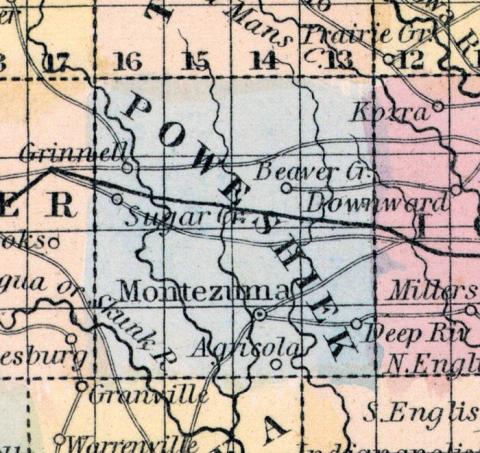POWESHIEK, a new county in the S. E. central part of Iowa, has an area of 576 square miles. It is drained by the head streams of English river, and by Beaver and Prairie creeks, affluents of Iowa river, which touches its N. E. extremity. The North fork of Skunk river flows through the S. W. part. The soil is fertile. In 1850 this county produced 26,455 bushels of Indian corn; 3011 of wheat, and 1253 pounds of wool. Named from an Indian chief. Capital, Montezuma. Population, 615. (Baldwin's New and Complete Gazetteer of the United States..., 1854)
POWESHIEK COUNTY lies between 41 ° 30' and 42° north latitude. Montezuma, the county seat, being exactly on the same line as Cleveland. The centre of the county is a hundred miles west of the Mississippi River, and fifty-five miles east of DesMoines, the capital of the State. There are five tiers of counties north of this, and three south, in the State. It embraces townships 78, 79, 80 and 81 north of the base line, in ranges 13, 14, 15 and 16 west of the 5th principal meridian, and contains 369,360 acres.
SETTLEMENT.—The first settlements in the county were made by Richard B. Ogden, Jesse Hiatt, D. Satchel, Martin Snyder, Gideon Willson, Isaac G. Willson, Richard Cheesman and J. Soey. Mr. Ogden came to the county in 1843, Messrs Satchel and Cheesman in 1844.
ORGANIZATION, ETC.—Poweshiek County was organized in April, 1848; the first county commissioners being Jacob Yeager, Martin Snyder and Richard B. Ogden. The signatures of these men appear to the acknowledgement of the record of the town plat of Montezuma, the first writing in the record books of the county, attested to by Stephen Moore, clerk B. C. C. P. C. The correctness of the description of the plat is certified to by Mahlon Woodward, County Surveyor. The date of this record is August 9th, 1848.
DESCRIPTION–SOIL.—The soil of this county is chiefly a rich, black loam, composed of vegetable deposit, with a clay subsoil, underlaid with carboniferous limestone. The depth of this vegetable deposit which has been accumulating for centuries, varies from two to six feet, and is almost inexhaustible in fertility. The ease with which the soil is cultivated is an item of great importance to the settler. One man with a team can tend from forty to fifty acres of corn well. There is no waste land in the county. It can all be brought under cultivation.
MINERALS.—In the southern part of the county, there is found to crop out a rock which is supposed to belong to the upper beds of the carboniferous limestone. It is used for underpinning to buildings, and makes excellent lime, from which the whole county is supplied. Bituminous coal is also abundant in the southern portion of the county; and doubtless both the limestone and the coal may be found in almost every township by proper effort. There is an excellent clay for brick throughout the county.
WATER.—There is not a township in Poweshiek County that has not an abundance of living water. Several of the streams afford sufficient water for ordinary mill purposes; and yet none of them are so large as to require any expensive bridging, which is quite an important item to the emigrant who is seeking a home in a new country. The streams are all easily bridged, the channels being invariably narrow and deep. Wells are seldom deeper than fourteen feet. The very best of water, sweet and clear, in great abundance, is obtained at a depth of twelve to fourteen feet.
CROPS.—The average yield of corn is from sixty to seventy-five bushels to the acre. There were many fields in this county the last summer which produced seventy-five bushels, and not a few a hundred bushels to the acre. Of wheat, the average yield is twenty to twenty-five bushels; of oats, sixty to seventy. The amount of Sorghum syrup produced to the acre will average about ninety to one hundred gallons; of potatoes, about one hundred bushels.
PRAIRIE AND TIMBER—The prairie of Poweshiek Connty is gently rolling throughout its whole extent. There are no marshes or swamps within her limits. The timber is good and much more abundant than in many counties of the State. By reference to the map, the proportion of timber to prairie land may readily be seen. This county has been represented in more than twenty regiments and batteries of Iowa troops, as well as in several regiments from other States. For the 10th Iowa Infantry she furnished more than 100 men; for the 28th Iowa Infantry, about 200; for the 40th, about 100; for the 4th Iowa Cavalry, about 100, and a smaller number for other regiments. In all, she has sent into the field about 600 men, mostly for three years.
SCHOOLS.—There are sixty sub-districts in the county, some of which have two schools. The number of persons between five and twenty-one years of age, is 2877. The schools are all in a flourishing condition; good teachers are employed; and in almost every sub-district, there is a good frame school house. The average compensation received by male teachers is about $6 per week; that of female teachers, about $5.
The county was named in honor of Poweshiek, an Indian chief, who presided over this district of territory, and lived and died somewhere in this vicinity; where he was buried, we have not been able to ascertain. It is said that he was friendly to the whites, and an honorable chief. (Hair's Iowa State Gazetteer..., 1865)

